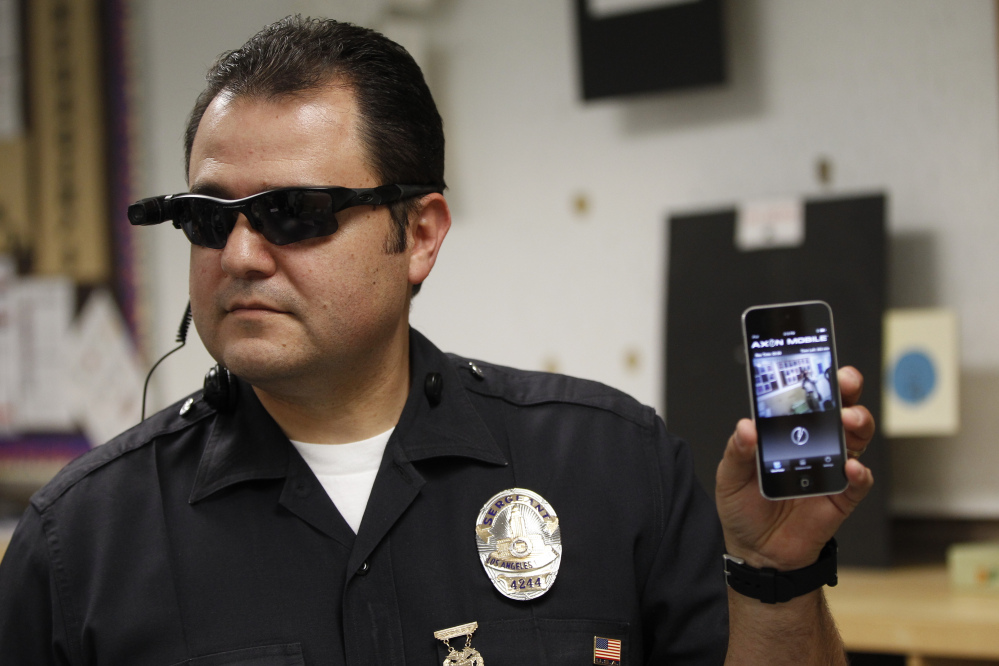LOS ANGELES — Officers at thousands of law enforcement agencies are wearing tiny cameras to record their interactions with the public, but in many cases the devices are being rolled out faster than departments are able to create policies to govern their use.
And some rank-and-file officers are worried the technology might ultimately be used to derail their careers if, for example, an errant comment about a superior is captured on tape.
Most law enforcement leaders and civil liberties advocates believe the cameras will ultimately help officers because the devices give them a way to record events from their point of view at a time when citizens armed with cellphones are actively scrutinizing their every move.
They say, however, that the lack of clear guidelines on the cameras’ use could potentially undermine departments’ goals of creating greater accountability of officers and jeopardize the privacy of both the public and law enforcement officers.
“This is a brave new world that we’re entering here, where citizens and police both are going to be filming each other,” said Chuck Wexler, the executive director of the Police Executive Research Forum, a nonprofit police research and policy organization.
The U.S. Justice Department has asked Wexler’s group to help develop guidelines for the cameras’ use, from when the devices should be turned on to how departments can protect the privacy of those who are inadvertently captured on the footage.
Equipping police with cameras isn’t a new concept. For decades police have used cameras mounted to the dashboards of their patrol cars – initially referred to with suspicion by officers as “indict-o-cams” until they discovered the footage exonerated them in most cases.
As camera technology and data storage has become more affordable and reliable, the use of portable cameras has increased over the last five years. Now officers in one of every six departments are patrolling with them on their chests, lapels or sunglasses, according to Scott Greenwood, general counsel for the national American Civil Liberties Union and an expert on the cameras.
With the push of a finger, officers can show the dangers and difficulties of their work. Unlike dashboard cameras, body cameras follow the officer everywhere – when their cruiser stays parked at the curb, when they go into homes on search warrants or when they are running after a suspect.
The cameras, if they aren’t turned off, can go with officers into a bathroom or locker room, or capture private conversations between partners. Footage can become evidence in a criminal case, or be used to discipline officers or exonerate them of false accusations.
Without strong policies, experts say, departments could lose the public’s trust. The public needs to know cameras aren’t only being turned on when it’ll help officers. But there are certain moments such as during the interview of a sexual assault victim or talk with a confidential informant when filming may be sensitive or even compromise a case, said Bay Area attorney Mike Rains, whose firm often represents officers and has worked on body camera policies with departments.
There’s still very little research into the impacts of these cameras on policing and their ripple effects on the criminal justice system, said Justin Ready, assistant professor at Arizona State’s department of criminology and criminal justice. But more studies are underway.
The police department in Rialto, Calif., concluded a yearlong University of Cambridge study last year that found an 89 percent drop in complaints against officers during the camera trial. The chief has since mandated its deployment to its roughly 90 sworn officers.
Copy the Story LinkSend questions/comments to the editors.



Success. Please wait for the page to reload. If the page does not reload within 5 seconds, please refresh the page.
Enter your email and password to access comments.
Hi, to comment on stories you must . This profile is in addition to your subscription and website login.
Already have a commenting profile? .
Invalid username/password.
Please check your email to confirm and complete your registration.
Only subscribers are eligible to post comments. Please subscribe or login first for digital access. Here’s why.
Use the form below to reset your password. When you've submitted your account email, we will send an email with a reset code.